Implicit surface
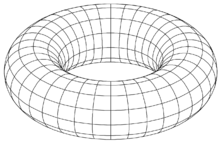
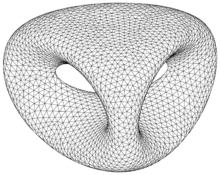
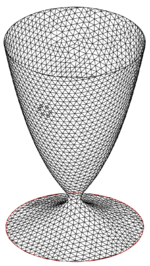
In mathematics an implicit surface is a surface in Euclidean space defined by an equation
An implicit surface is the set of zeros of a function of 3 variables. Implicit means, that the equation is not solved for x or y or z.
The graph of a function is usually described by an equation  and is called an explicit representation. The third essential description of a surface is the parametric one:
and is called an explicit representation. The third essential description of a surface is the parametric one:
 , where the x-, y- and z-coordinates of surface points are represented by three functions
, where the x-, y- and z-coordinates of surface points are represented by three functions  depending on common parameters
depending on common parameters  . The change of representations is unsually simple only, when the explicit representation
. The change of representations is unsually simple only, when the explicit representation  is given:
is given:  (implicit),
(implicit),  (parametric).
(parametric).
Examples:
- a plane
 ,
, - a sphere
 ,
, - a torus
 ,
, - surface of genus 2:
 (s. picture),
(s. picture), - surface of revolution
 (s. picture wine glas).
(s. picture wine glas).
For a plane, a sphere and a torus there exist simple parametric representations. This is not true for the 4. example.
The implicit function theorem describes conditions, under which an equation  can be solved (theoretically) for x, y or z. But in general the solution may not be feasible. This theorem is the key for the computation of essential geometric features of the surface: tangent planes, surface normals, curvatures (s. below). But they have an essential drawback: their visualization is difficult.
can be solved (theoretically) for x, y or z. But in general the solution may not be feasible. This theorem is the key for the computation of essential geometric features of the surface: tangent planes, surface normals, curvatures (s. below). But they have an essential drawback: their visualization is difficult.
- If
 is polynomial in x,y and z, the surface is called algebraic.
is polynomial in x,y and z, the surface is called algebraic.
- Example 5. is non algebraic.
Despite the visualization of an implicit surface is difficult, they provide rather simple techniques to generate theoretically (e.g. Steiner surface) and practically (s. below) interesting surfaces.
Formulas
Throughout the following considerations the implicit surface is represented by an equation
 where function
where function  meets the necessary conditions of differentiability. The partial derivatives of
meets the necessary conditions of differentiability. The partial derivatives of
 are
are  .
.
Tangent plane and normal vector
A surface point  is called regular, if
is called regular, if
 ,
,
otherwise the point is singular.
The equation of the tangent plane at a regular point  is
is
 , and
, and
 is a normal vector.
is a normal vector.
Normal curvature
In order to keep the formula simple the arguments  are omitted:
are omitted:
 is the
is the
normal curvature of the surface at a regular point for the unit tangent direction  .
.  is the Hessian matrix of
is the Hessian matrix of  (matrix of the second derivatives).
(matrix of the second derivatives).
The proof of this formula relies (as in the case of an implicit curve) on the implicit function theorem and the formula for the normal curvature of a parametric surface.
Applications of implicit surfaces
As in the case of implicit curves it is an easy task to generate implicit surfaces with desired shapes by applying algebraic operations (addition, multiplication) on simple premitives.
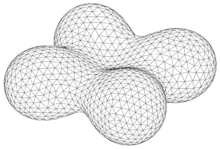
Equipotential surface of point charges
The electrical potential of a point charge  at point
at point  generates at point
generates at point  the potential (omitting physical constants)
the potential (omitting physical constants)
-
 .
.
The equipotential surface for the potential value  is the implicit surface
is the implicit surface  which is a sphere with center at point
which is a sphere with center at point  .
.
The potential of (e.g.)  point charges is represented by
point charges is represented by
-
 .
.
For the picture the four charges are equal 1 and are located at the points
 . The displayed surface is the equipotential surface (implicit surface)
. The displayed surface is the equipotential surface (implicit surface)  .
.
Constant distance product surface
A Cassini oval can be defined as the point set for which the product of the distances to two given points is constant (for an ellipse the sum is constant !). In a similar way implicit surfaces can be defined by a constant distance product to several fixed points.
In picture metamorphoses the upper left surface is generated by this rule: With
the constant distance product surface  is displayd.
is displayd.
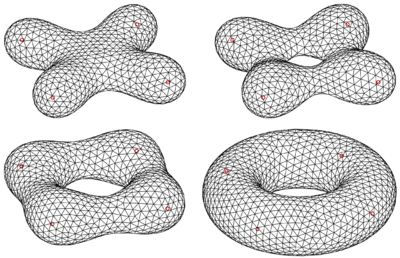
Metamorphoses of implicit surfaces
A further simple method to generate new implicit surfaces is called metamorphoses of implicit surfaces:
For two implicit surfaces  (in picture: a constant distance product surface and a torus) one defines new surfaces using the design parameter
(in picture: a constant distance product surface and a torus) one defines new surfaces using the design parameter ![\mu \in [0,1]](../I/m/40c22bb74ef18fef1869b28e9a8a702b.png) :
:
For the picture the design parameter is:  .
.

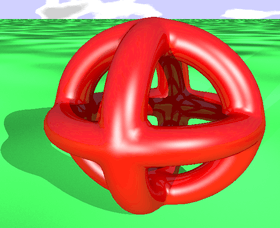
Smooth approximationen of several implicit surfaces
Analogously to the smooth approximation with implicit curves the equation
represents for suitable parameters  smooth approximations of three intersecting tori with equations
smooth approximations of three intersecting tori with equations
 ,
, ,
, .
.
(For the picture the parameters are:  )
)
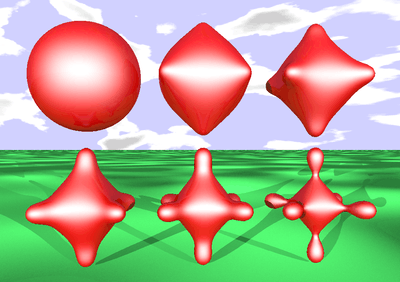
Visualization of implicit surfaces
The visualization of implicit surfaces needs great efforts. Essentially there are two ideas visualizing an implicit surface. One generates a net of polygons which is visualized (see surface triangulation) and the second relies on ray tracing which determines intersection points of rays with the surface.
External links
- Sultanow: Implizite Flächen
- Hartmann: Geometry and Algorithms for COMPUTER AIDED DESIGN
- GEOMVIEW
- K3Dsurf: 3d surface generator
- SURF: Visualisierung algebraischer Flächen
References
- Thorpe: Elementary Topics in Differential Geometry, Springer-Verlag, New York, 1979, ISBN 0-387-90357-7


